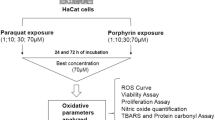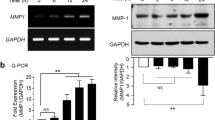Abstract
Metallothioneins (MT) are a family of intracellular, cysteine-rich, zinc-binding proteins. Their expression is constitutive but can also be induced at the transcriptional level by various stimuli. In this study, we exposed HaCaT human keratinocytes to excess zinc (ZnCl2) or to zinc deprivation by the diffusible chelator NNN’N’-tetrakis(2-pyridylmethyl) ethylene diamine (TPEN), and to ultraviolet B (UVB) irradiation. We examined both cell proliferation and MT expression. Cell proliferation was maximally stimulated by 100 ΜM Zn2+ supply and was markedly inhibited by zinc deprivation or UVB irradiation. Zinc and UVB irradiation both increased MTI and/or MTII as detected by immunocytochemistry and enhanced the baseline level of MT-IIA mRNA, whereas TPEN treatment inhibited MT basal expression. Zinc partially prevented the concentration-dependent, UVB-induced decrease in cell proliferation. On the other hand, TPEN partially prevented the UVB-induced increase in MTIIA mRNA. These results suggest that zinc is involved in defense mechanisms of skin keratinocytes and in their stress-induced response.
Similar content being viewed by others
References
M. Margoshes and B. L. Vallee, A cadmium protein from equine kidney corex,J. Am. Chem. Soc. 79, 4813–4814 (1957).
R. Palmiter, S. Findley, T. Whitmore, and D. Durnam, MT-III, a brain specific member of the metallothionein gene family,Proc. Natl. Acad. Sci. USA 89, 6333–6337 (1992).
C. J. Quaife, S. D. Findley, J. C. Erickson, G. J. Froelic, E. J. Kelly, B. P. Zambrowicz, et al., Induction of a new metallothionein isoform (MT-IV) occurs during differentia- tion of stratified squamous epithelia,Biochemistry 33, 7250–7259 (1994).
J. KÄgi, Overview of metallothioneins, inMethods in Enzymology, Volume 205, Part B, J. F. Riordan and B. L. Valee, eds., Academic, San Diego, CA, pp. 613–626 (1991).
M. Karasawa, N. Nishimura, H. Nishimura, C. Tohyama, H. Hashiba, and T. Kuroki, Localization of metallothionein in hair follicles of normal skin and the basal cell layer of hyperplastic epidermis: possible association with cell proliferation,J. Invest. Dermatol. 96, 97–100 (1991).
W. Nagel and B. Vallee, Cell cycle regulation of metallothionein in human colonic cancer cells,Proc. Natl. Acad. Sci. USA 92, 579–583 (1995).
J. W. Bauman, J. Liu, Y. P. Liu, and C. D. Klaassen, Increase in metallothionein produced by chemicals that induce oxidative stress,Toxicol. Appl. Pharmacol. 110, 347–354 (1991).
E. J. Dudek, J. G. Peak, R. M. Roth, and M. J. Peak, Isolation of V79 fibroblast cell lines containing elevated metallothionein levels that have increased resistance to the cytotoxic effects of ultraviolet-A radiation,Photochem. Photobiol. 58, 836–840 (1993).
S. Kobayashi, Y. Hirota, J. Sayato-Suzuki, M. Takehana, H. Nishimura, and C. Tohyama, Possible role of metallothionein in the cellular defense mechanism against UVB irradiation in neonatal human skin fibroblasts,Photochem. Photobiol. 59, 650–656 (1994).
J. Abel and N. de Ruiter, Inhibition of hydroxyl-radical-generated DNA degradation by metallothionein,Toxicol. Lett. 47, 191–196 (1989).
L. Chubatsu and R. Meneghini, Metallothionein protects DNA from oxidative dam- age,Biochem. J. 291, 193–198 (1993).
M. G. Cherian, S. B. Howell, N. Imura, C. D. Klaassen, J. Koropatnick, J. S. Lazo, et al., Contemporary issues in toxicology—Role of metallothionein in carcinogenesis,Toxicol. Appl. Pharmacol. 126, 1–5 (1994).
M. O. Parat, M. J. Richard, J. C. Béani, and A. Favier, Involvement of zinc in intracellular oxidant / antioxidant balance,Biol. Trace Element Res. 60, 187–204 (1997).
P. Boukamp, R. Petrussevka, D. Breitkreutz, J. Hornung, A. Markham, and N. Fusenig, Normal keratinization in a spontaneously immortalized aneuploid human keratinocyte cell line,J. Cell Biol. 106, 761–771 (1988).
B. Jasani and M. E. Elmes, Immunocytochemical detection of metallothionein, inMethods in Enzymology, Volume 205, Part B, J. F. Riordan and B. L. Vallee, eds., Academic, San Diego, CA, pp. 95–107 (1991).
A. Anstey, R. Marks, C. Long, H. Navabi, A. Pearse, D. Wynford-Thomas, et al., In vivo photoinduction of metallothionein in human skin by ultraviolet irradiation,J. Pathol. 178, 84–88 (1996).
P. Kille, A. Hemmings, and E. A. Lunney, Memories of metallothionein,Biochim. Biophys. Acta 1205, 151–161 (1994).
M. A. Dunn, T. L. Blalock, and R. J. Cousins, Metallothionein,Proc. Soc. Exp. Biol. Med. 185, 107–119 (1987).
R. Richards, A. Heguy, and M. Karin, Structural and functional analysis of the human metallothionein-Ia gene: differential induction by metal ions and glucocorticoids,Cell 37, 263–272 (1984).
M. Czupryn, W. E. Brown, and B. L. Vallee, Zinc rapidly induces a metal responsive element-binding factor,Proc. Natl. Acad. Sci. USA 89, 10395–10399 (1992).
L. Minichiello, P. Remondelli, S. Cigliano, S. Bonatti, and A. Leone, Interactions of nuclear proteins from uninduced, induced and superinduced HeLa cells with metal regulatory elements MRE3 and 4 of the human metallothionein IIa-encoding gene,Gene 143, 289–294 (1994).
W. Lee, A. Haslinger, M. Karin, and R. Tjian, Activation of transcription by two fac- tors that bind promoter and enhancer sequences of the human metallothionein gene and SV40,Nature 325, 368–372 (1987).
B. L. Vallee, The function of metallothionein,Neurochem. Int. 27, 23–33 (1995).
G. W. Verhaegh, M. O. Parat, M. J. Richard, and P. Hainaut, Modulation of p53 protein conformation and DNA-binding activity by intracellular chelation of zinc,Mol. Carcinog. 21, 205–214 (1998).
W. Maret, Oxidative metal release from metallothionein via zinc-thiol/disulfide interchange,Proc. Natl. Acad. Sci. USA 31, 237–241 (1994).
M. J. McCabe Jr., S. A. Jiang, and S. Orrenius, Chelation of intracellular zinc triggers apoptosis in mature thymocytes,Lab. Invest. 69, 101–110 (1993).
D. R. Winge and J. S. Garvey, Antigenicity of metallothionein,Proc. Natl. Acad. Sci. USA 80, 2472–2476 (1983).
J. Zeng, R. Heuchel, W. Schaffner, and J. KÄgi, Thionein (apometallothionein) can modulate DNA binding and transcription activation by zinc finger containing factor sp1,FEBS Lett. 279, 310–312 (1991).
M. C. Posewitz and D. E. Wilcox, Properties of the Spl zinc finger 3 peptide: coordi- nation chemistry, redox reactions, and metal binding competion with metallothionein,Chem. Res. Toxicol. 8, 1020–1028 (1995).
C. D. Klaassen, S. Choudhuri, J. M. McKim, Jr., L. D. Lehman-McKeeman, and W. C. Kershaw, In vitro and in vivo studies on the degradation of metallothioneins,Environ. Health Perspect. 102, 141–146 (1994).
M. Sato, M. Sasaki, T. Oguro, Y. Kuroiwa, and T. Yoshida, Induction of metallothionein synthesis by glutathione depletion after trans and cis-stilbene oxide administration in rats,Chem. Biol. Interact. 98, 15–25 (1995).
M. O. Parat, M. J. Richard, S. Pollet, C. Hadjur, A. Favier, and J. C. Béani, Zinc and DNA fragmentation in keratinocyte apoptosis: its inhibitory effect in UVB-irradiated cells,J. Photochem. Photobiol. B: Biol. 37, 101–106 (1997).
S. Morana, J. Li, E. W. Springer, and A. Eastman, The inhibition of etoposide-induced apoptosis by zinc is associated with modulation of intracellular pH,Int. J. Oncol. 5, 153–158 (1994).
D. A. Suhy and T. V. O’Halloran, Metal-responsive gene regulation and the zinc metalloregulatory model,Met. Ions Biol. Syst. 32, 557–578 (1996).
T. Hatayama, Y. Tsukimi, T. Wakatsuki, T. Kitamura, and H. Imahara, Characteristic induction of 70000 Da-Heat Shock Protein and metallothionein by zinc in HeLa cells,Mol. Cell. Biochem. 112, 143–153 (1992).
T. M. Bray and W. J. Bettger, The physiological role of zinc as an antioxidant,Free Radical Biol. Med. 8, 281–291 (1990).
K. Hanada, R. W. Gange, E. Siebert, and T. Hassan, Protective effect of cadmium chloride against UVB injury in mouse skin and in cultured human cells: a possible role of cadmium-induced metallothionein.Photodermatol. Photoimmunol. Photomed. 8, 111–115 (1991).
T. Ota, K. Hanada, and I. Hashimoto, The effect of cold stress on UVB injury in mouse skin and cultured keratinocytes,Photochem. Photobiol. 64, 984–987 (1996).
P. Angel, A. Poting, U. Mallick, H. J. Rahmsdorf, M. Schopp, and P. Herrlich, Induction of metallothionein and other mRNA species by carcinogens and tumor promoters in primary human skin fibroblasts,Mol. Cell. Biol. 6, 1760–1766 (1986).
Y. Ren and A. Smith, Mechanism of metallothionein gene regulation by heme hemo- pexin,J. Biol. Chem. 270, 23988–23995 (1995).
C. Hansen, E. Ablett, A. Green, R. A. Sturm, I. S. Dunn, D. P. Fairlie, et al., Biphasic response of the metallothionein promoter to ultraviolet radiation in human melanoma cells,Photochem. Photobiol. 65, 550–555 (1997).
A. Markant and J. Pallauf, Metallothionein and zinc as potential antioxidants in radical-induced lipid peroxidation in cultured hepatocytes,J. Trace Elements Med. Biol. 10, 88–95 (1996).
C. E. Hildebrand and G. F. Strniste, Ultraviolet light inactivation of zinc-mediated metallothionein induction in normal and repair deficient human cells,Mutat. Res. 95, 417–426 (1982).
Author information
Authors and Affiliations
Additional information
Author to whom reprint requests should be addressed.
Rights and permissions
About this article
Cite this article
Parat, MO., Richard, MJ., Meplan, C. et al. Impairment of cultured cell proliferation and metallothionein expression by metal chelator NNN’ N’-tetrakis-(2-pyridylmethyl) ethylene diamine. Biol Trace Elem Res 70, 51–68 (1999). https://doi.org/10.1007/BF02783849
Received:
Accepted:
Issue Date:
DOI: https://doi.org/10.1007/BF02783849




